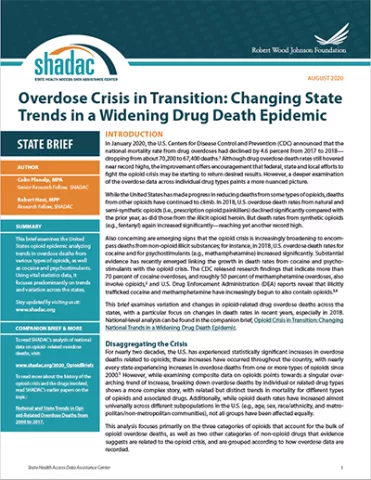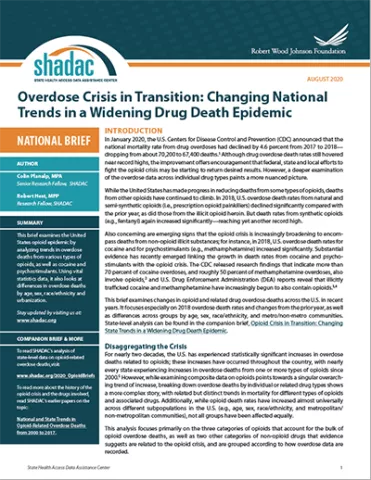For nearly two decades, the United States has experienced a growing and evolving crisis of substance abuse and addiction; a crisis illustrated by statistically significant increases in overdose deaths directly from, or related to, opioids. These increases have occurred throughout the country, as the annual number of drug overdose deaths has nearly quadrupled from 17,500 in 2000 to 67,400 in 2018, and nearly every state has experienced increases in overdose deaths from one or more types of opioids since 2000.1,2
In the years since the U.S. Centers for Disease Control and Prevention (CDC) declared overdoses from prescription painkillers an “epidemic” in 2011, the opioid overdose crisis has evolved rapidly from a problem tied mostly to prescription opioid painkillers to one driven by illicitly trafficked heroin, to one marked by the rise of synthetic opioids, to most recently one with surging numbers of overdose deaths related to cocaine and psychostimulants—non-opioid illicit substances that have been linked to the opioid crisis via emerging evidence from both the CDC and U.S. Drug Enforcement Administration (DEA).3,4
Variations in the opioid and opioid-related drug overdose crisis have become especially pronounced in recent years. While data from the CDC has shown that drug overdose deaths overall and opioid overdose deaths in aggregate declined a small but statistically significant amount from 2017 to 2018 (4.6 percent), examining data at a more granular level shows a more nuanced picture. While deaths from prescription opioids and heroin declined in 2018, deaths from synthetic opioids, cocaine, and psychostimulants increased significantly to reach new record highs.
As a result of these more current variations, SHADAC’s annually produced opioid and opioid-related drug overdose briefs have shifted slightly in order to particularly focus on changes in overdose deaths across the nation and among the states in more recent years, especially in 2018. The briefs provide high-level information about opioids and opioid addiction, present the historical context for the epidemic of opioid and related addiction and mortality in the United States, and examine trends in opioid-related mortality across the country and among population subgroups between 2017 and 2018.
Related Resources
The Opioid Epidemic in the United States
50-State Analysis of Drug Overdose Trends: The Evolving Opioid Crisis Across the States (Infographics)
After drop in 2018, newer data indicate a resurgence in drug overdose deaths (Blog)
The Evolving Opioid Epidemic: Observing the Changes in the Opioid Crisis through State-level Data (Webinar)
The Opioid Epidemic: National and State Trends in Opioid-Related Overdose Deaths from 2000 to 2017 (Briefs)
1 Hedegaard, H., Miniño, A.M., & Warner, M. (2020). Drug overdose deaths in the United States, 1999-2018 [Data brief No. 356]. Retrieved from https://www.cdc.gov/nchs/data/databriefs/db356-h.pdf
2 State Health Access Data Assistance Center (SHADAC). (2019). The opioid epidemic: State trends in opioid-related overdose deaths from 2000 to 2017 [PDF file]. Available from http://www.shadac.org/2017OpioidBriefs
3 Kariisa, M., Scholl, L., Wilson, N., Seth, P., & Hoots, B. (2019, May 3). Drug overdose deaths involving cocaine and psychostimulants with abuse potential—United States, 2003-2017. MMWR, 68(17), 388-395. DOI: http://dx.doi.org/10.15585/mmwr.mm6817a3
4 Drug Enforcement Administration (DEA) Strategic Intelligence Section. (2020). 2019 National Drug Threat Assessment [DEA-DCT-DIR-007-20]. Retrieved from https://www.dea.gov/sites/default/files/2020-01/2019-NDTA-final-01-14-2020_Low_Web-DIR-007-20_2019.pdf


